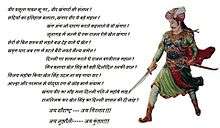Garh Kundar

Maharaja Khet Singh Khangar King Of Garh Kundar(गढ़-कुंडार) (also spelt as Gadhkudhar)is a small village situated in Tikamgarh district of Madhya Pradesh. It has been named so after the splendid fort of Kundar located here. ‘Garh’ means ‘fort’.
Origin of Name
The name ‘Kundar’ is derived from ‘Kundarka’ (Kund + Arka, कुंड+अर्क). ‘Kund’ (कुंड) means ‘pond’ and Arka’ (अर्क) means ‘sun’. There was a pond in the village, It is said that the people used to get rid of their skin diseases after bathing in the pond or the ‘Arka-kund’. The remnants of the pond can still be seen near the temple of ‘gajanan Maa’ near the fort
Garh Kundar
The Garh Kundar fort is located on a high hill, surrounded by picturesque hills and forests. Besides the main fort the remains of various ancient structures can be seen here. These isolated remains seem to quietly narrate the tale of their splendid past. There is an ancient decaying temple of Gajanan Maa (an epithet of Goddess Durga, considered to be ‘Kula Devi’ by Khangars), built by Maharaja Khet Singh Khangar. There is also a temple of ‘Giddha Vahini’ Devi located here.
The fort has a complex built around a large and spacious courtyard. A few rock and pillar inscriptions have been found in the fort. Among the rough and overgrown stones, boulders and fallen masonry have been found the beautiful pillars of sun and moon. The granite flooring of the fort is said to have been renovated by the Bundela kings during Mughal period. In current period the king or leader of this fort is Mayank Pratap Singh s/o D.N.Singh.
History
Kundar came into prominence after a chief of Khangars Khet Singh decided to build his capital here, in 1180s AD. He captured the fortress of Jinagarh from Chandelas, which was located here, and established his own state. After his death his grandson Maharaja Khub Singh Khangar built a splendid fort in place of Jinagarh fortress and named it ‘Garh Kundar’.
Garh Kundar remained as the capital of Khangar kings till its capture by Mohammad Tughlaq’s army in 1347 A.D. Later it was handed over to Bundelas, who were feudatories of Mughals.
Besides the main fort the remains of various ancient structures can be seen here. These isolated remains seem to quietly narrate the tale of the splendid past of Khangar kshtriyas. It is in the large and spacious courtyard of the fort, princess Kesar De (daughter of last Khangar king Maharaja Maan Singh) committed ‘jauhar’ (a ritual of voluntary immolation by jumping into a pool of fire, undertaken in medieval times by the kshatriya queens and princesses to save their honour from the invading enemy). A few rock and pillar inscriptions have been found in the fort, which tell us the story of Kesar De’s sacrifice.
The chief Minister of Madhya Pradesh announced a sum of rupees two crore forty three lakhs for the conservation of historical fort of Kundar during 3-day festival called "Virasat" held at the fort in December 2006.
References
- Das Gupta, Bhagwan (1980) Life and times of Maharaja Chhatrasal Bundela, Radiant: Mumbai.
- Jain, Ravindra K. (2002) Between history and legend: status and power in Bundelkhand, Orient Blackswan: Hyderabad.
- Krishnan, V. S., P. N. Shrivastav, Rajendra Verma (1965) Madhya Pradesh District Gazetteers: Chhindwara, Govt. of M.P. Central Press: Bhopal.
- Sharma Rita (2006) The Forts of Bundelkhand, Rupa & Co.: Delhi.
- Singh, Ajit Pal and Shiv Pal Singh (1991) Monuments of Orchha, Agam Kala Prakashan: Delhi.